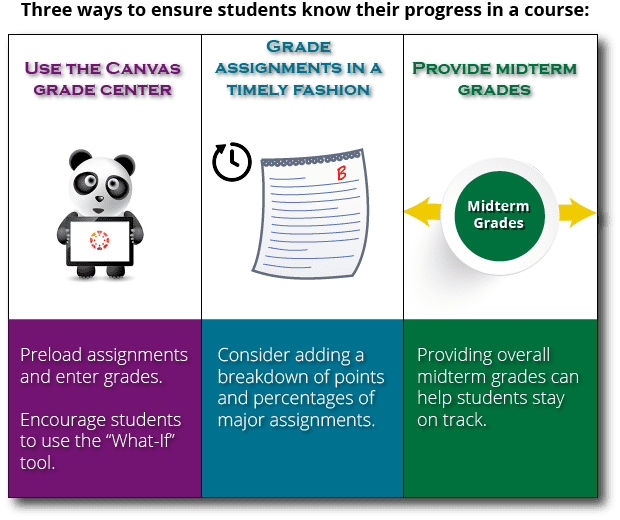Giving Grades and Feedback
Grades
A 2007 Educause national study of more than 25,000 seniors and freshmen reported that students find the ability to keep track of their grades on assignments and tests within a Learning Management System (LMS) like Canvas the most useful tool in the system (Caruso & Salaway, 2007). In fact, in a recent 2016 study, the LMS company Blackboard found that students who checked their grades more frequently within the LMS were much more likely to earn a high grade in courses than those who checked their grades less frequently (Fritz & Whitmer, 2017).

Although you may not use Canvas for your student grades, students will still want to know what their progress is in a course.
The same Educause study that highlights students preference for online grade centers shows that while students highly value being able to access their grades through an LMS like Canvas, one of the lesser used features of the LMS was getting assignments back from instructors (Caruso & Salaway, 2007). Building on this trend, many studies point to students either misunderstanding feedback or not using it at all (Hattie & Timperley, 2007).
The following table explains some of the reasons for why students don’t use feedback with examples of strategies for how to avoid them:
| Problem | Solution |
| Feedback may not be timely. | Provide feedback on assignments within a reasonable amount of time, but particularly before students turn in the next piece of work that will receive feedback. |
| Feedback may be relevant only to material that has already been covered and won’t be addressed again within the course. | Provide feedback specifically to help students master skills they will need in the next activity or assignment or throughout the rest of the course. One way of structuring this is to provide specific feedback on drafts of essays and activities, and then a letter grade and one or two overall comments on a version of the activity that students have revised based on your comments. This will help to make the feedback relevant to students but not add excessively to your grading load. |
| Feedback may be too general (e.g. review the readings). | Provide feedback that points students to specific chapters, concepts, and examples (e.g. review Chapter 1, specifically pages 3-6). |
| Feedback may instruct the student to do something they haven’t been taught how to do (e.g. be more analytical). | Provide specific guidance for students in how to do something by breaking down complex concepts in your feedback, or provide a link to remedial information or skill development support. |
| Feedback may be focused on students’ fulfillment of assignment criteria (e.g. fonts in essays, titling of assignments) rather than skills or knowledge that spans the length of the course. | Use a checklist for fulfillment of assignment criteria and assign a certain amount of points for the criteria as a whole. Focus more detailed feedback on larger concepts and skills. |
| There may be no follow-up to check if students have taken action, so students can ignore feedback. | If students aren’t required to do anything with feedback, they won’t. Allowing revisions is one way to ensure students will use the feedback you’ve provided. |
(Gibbs & Simpson, 2004, p. 25)
References
Caruso, J.B., & Salaway, G. (2007). The ECAR study of undergraduate students and information technology. Educause Center for Applied Research.
Fritz, J., & Whitmer, J. (2017). Learning analytics research for LMS course design: Two studies. Educause.
Gibbs, G., & Simpson, C. (2004). Conditions under which assessment supports student learning. Learning and Teaching in Higher Education, 1, 3-31.
Hattie, J., & Timperley, H. (2007). The power of feedback. Review of Educational Research 77(81), 81-112.